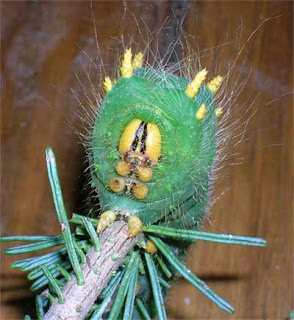From the Auburn University website:

Imperial Moth
Eacles imperialis (Drury) (Saturniidae)
Department of Entomology & Plant Pathology
Auburn University
3/2000
The imperial moth is distributed throughout the eastern United States west to Texas and Kansas. The caterpillar feeds on foliage of a variety of broadleaf and coniferous trees. Some common hosts are oaks, sweetgum, sycamore, elm, hickories, walnut, maple, basswood, honeylocust, pines, red cedar, and bald cypress. In Alabama, the caterpillar is found on both pines and hardwoods.
Life Cycle, Description, and Habits
The full-grown caterpillar is 75-100 mm long. It occurs in two color forms, green and brown. In the green form, the head is orange-yellow with vertical black or dark stripes on sides and front. The thoracic legs are yellow. The body is green and thinly clothed with long whitish hairs. The second and third thoracic segments each bear a pair of stubby, rough yellow horns, and rows of smaller yellow spines occur along the body to the rear. The last abdominal segment bears conspicuous yellow and black triangular plates. The spiracles along the sides are large, oval and pale yellow to cream in color. In the brown color form, the body, horns, and spines are tan to reddish brown. When fully grown, larvae leave foliage and pupate in the soil. Two broods may possibly occur each year in Alabama; however, the caterpillar is most commonly seen in August and September.



